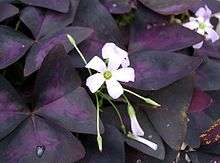Oxalis triangularis
| Oxalis triangularis | |
|---|---|
 | |
| Scientific classification | |
| Kingdom: | Plantae |
| Clade: | Angiosperms |
| Clade: | Eudicots |
| Clade: | Rosids |
| Order: | Oxalidales |
| Family: | Oxalidaceae |
| Genus: | Oxalis |
| Species: | O. triangularis |
| Binomial name | |
| Oxalis triangularis | |
| Synonyms | |
|
Oxalis regnellii | |
Oxalis triangularis, commonly called false shamrock, is a species of edible perennial plant in the Oxalidaceae family. It is endemic to Brazil.[1] This woodsorrel is typically grown as a houseplant but can be grown outside in USDA climate zones 8a–11, preferably in light shade.
The deep maroon leaves are trifoliate, like species in the clover genus Trifolium which are commonly called shamrock, hence the name “false shamrock”. An interesting feature is that the leaves close like an umbrella at night (See the timelapse video below). The white or pale pink five-petalled flowers also close at night.[2]
Description
Growing to 50 cm (20 in) tall and broad, the subspecies O. triangularis subsp. papilionacea, the purpleleaf false shamrock, is hardy in mild and coastal areas of Britain, down to −5 °C (23 °F), and has won the Royal Horticultural Society’s Award of Garden Merit.[3] It is a perennial plant without aerial stem, formed by leaves borne by a long petiole emerging at the ground level of a tuberous rhizome (5 cm long, over 10 - 15 mm in diameter, fully covered with scales). The leaf is formed of three sessile leaflets (or very short petiole), obtriangular to obovate-triangular, glabrous, arranged in the same plane perpendicular to the petiole.[4]
The five densely haired sepals are 5 to 5.5 mm long, narrow and slightly reddish at the top. The five white petals are about 2 inches long and oblong-lanceolate. The stamens and the stylus are densely hairy.The mostly four to nine in undergraduate rosettes arranged leaves are divided into petiole and leaf blade. The limb of the wild species is green but purple cultivars have been selected for horticulture. The petiole , soft, whitish, is 15 to 25 cm long. Flowering takes place from spring to autumn.[3]
Movement
The leaves of O. triangularis move in response to light levels, opening in high ambient light (in the day) and closing at low light levels (at night). During this movement, the leaflets fold at the level of the central vein.This movement is not due to growth and is instead powered by changes in turgor pressure in cells at the base of the leaf. It is an example of photonasty.
Cultivation
O. triangularis requires bright or direct sunlight supplemented with a cool indoor temperature of 15 degrees Celsius (60 degrees Fahrenheit). It can tolerate higher indoor temperatures but will go into dormancy prematurely and/or begin to take on a "tired" appearance if temperatures go above 27 degrees Celsius (80 degrees Fahrenheit) for prolonged periods of time. It thrives in an average potting soil with good drainage.
Mature plants are cut back to the soil every 3–5 years in early summer or during the dormancy period. Young plants are cut back to the soil every year in early summer or during the dormancy period, until they reach maturity. Fearing frost, they are usually grown indoors. They are planted in soil rich in humus and well drained. In winter, they should not be watered.[5]
Usage
The leaves are eaten raw or cooked and have an acidic taste due to their oxalic acid content. Leaves and flowers can be used as a decoration for salads, when consuming larger amounts of leaves, the oxalic acid can cause discomfort. The rhizomes are eaten raw or cooked and have a sweet taste.
Range
The species is distributed in several countries of South America: Brazil, Bolivia, Argentina and Paraguay. It is a neophyte in the United States in the states of Florida and Louisiana.
Propagation
Oxalis triangularis grows from corms, propagated by division. Like other corms, it goes through regular dormancy periods; at the end of each period, the corms can be unearthed, offsets cut and replanted in appropriate soil, where they will grow into new plants.[6]
Sources
- "Oxalis triangularis". GardenWeb.
- 2007 IUCN Red List of Threatened Species (for conservation status)
- Zimmerman, Maureen Williams. Sunset House Plants A to Z: How to Choose, Grow and Display Sunset Publishing Corp. 1998. ISBN 0-376-03337-1
References
- ↑ "Low Maintenance Houseplants: Oxalis Triangularis". Easy to Grow Bulbs. Retrieved 15 April 2018.
- ↑ "AGM Plants - Ornamental" (PDF). Royal Horticultural Society. July 2017. p. 70. Retrieved 14 April 2018.
- 1 2 "RHS Plantfinder - Oxalis triangularis subsp. papilionacea". Retrieved 16 April 2018.
- ↑ Guy L. Nesom: Taxonomic notes on acaculate oxalis (Oxalidaceae) in the United States. In: Phytologia , Volume 91, Issue 3, December 2009.
- ↑ Flora of Peru (Volume 2) . In: J. Francis Macbride (ed.): Botanical Series . Volume III , No. 2 . Publication (Field Museum of Natural History), Chicago 1949, pp. 83-84
- ↑ "Oxalis regnellii atropurpurea - Purple Shamrock". Plant of the week.
External links
| Wikimedia Commons has media related to: |
